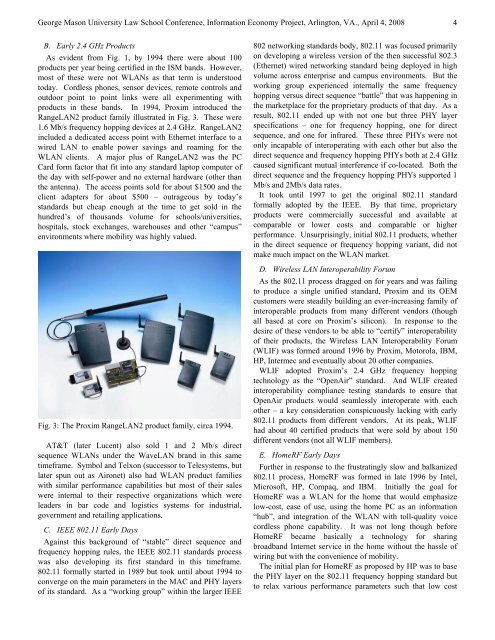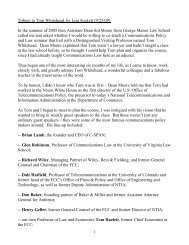History of Wireless Local Area Networks (WLANs) - Information ...
History of Wireless Local Area Networks (WLANs) - Information ...
History of Wireless Local Area Networks (WLANs) - Information ...
Create successful ePaper yourself
Turn your PDF publications into a flip-book with our unique Google optimized e-Paper software.
George Mason University Law School Conference, <strong>Information</strong> Economy Project, Arlington, VA., April 4, 2008<br />
B. Early 2.4 GHz Products<br />
As evident from Fig. 1, by 1994 there were about 100<br />
products per year being certified in the ISM bands. However,<br />
most <strong>of</strong> these were not <strong>WLANs</strong> as that term is understood<br />
today. Cordless phones, sensor devices, remote controls and<br />
outdoor point to point links were all experimenting with<br />
products in these bands. In 1994, Proxim introduced the<br />
RangeLAN2 product family illustrated in Fig. 3. These were<br />
1.6 Mb/s frequency hopping devices at 2.4 GHz. RangeLAN2<br />
included a dedicated access point with Ethernet interface to a<br />
wired LAN to enable power savings and roaming for the<br />
WLAN clients. A major plus <strong>of</strong> RangeLAN2 was the PC<br />
Card form factor that fit into any standard laptop computer <strong>of</strong><br />
the day with self-power and no external hardware (other than<br />
the antenna). The access points sold for about $1500 and the<br />
client adapters for about $500 – outrageous by today’s<br />
standards but cheap enough at the time to get sold in the<br />
hundred’s <strong>of</strong> thousands volume for schools/universities,<br />
hospitals, stock exchanges, warehouses and other “campus”<br />
environments where mobility was highly valued.<br />
Fig. 3: The Proxim RangeLAN2 product family, circa 1994.<br />
AT&T (later Lucent) also sold 1 and 2 Mb/s direct<br />
sequence <strong>WLANs</strong> under the WaveLAN brand in this same<br />
timeframe. Symbol and Telxon (successor to Telesystems, but<br />
later spun out as Aironet) also had WLAN product families<br />
with similar performance capabilities but most <strong>of</strong> their sales<br />
were internal to their respective organizations which were<br />
leaders in bar code and logistics systems for industrial,<br />
government and retailing applications.<br />
C. IEEE 802.11 Early Days<br />
Against this background <strong>of</strong> “stable” direct sequence and<br />
frequency hopping rules, the IEEE 802.11 standards process<br />
was also developing its first standard in this timeframe.<br />
802.11 formally started in 1989 but took until about 1994 to<br />
converge on the main parameters in the MAC and PHY layers<br />
<strong>of</strong> its standard. As a “working group” within the larger IEEE<br />
802 networking standards body, 802.11 was focused primarily<br />
on developing a wireless version <strong>of</strong> the then successful 802.3<br />
(Ethernet) wired networking standard being deployed in high<br />
volume across enterprise and campus environments. But the<br />
working group experienced internally the same frequency<br />
hopping versus direct sequence “battle” that was happening in<br />
the marketplace for the proprietary products <strong>of</strong> that day. As a<br />
result, 802.11 ended up with not one but three PHY layer<br />
specifications – one for frequency hopping, one for direct<br />
sequence, and one for infrared. These three PHYs were not<br />
only incapable <strong>of</strong> interoperating with each other but also the<br />
direct sequence and frequency hopping PHYs both at 2.4 GHz<br />
caused significant mutual interference if co-located. Both the<br />
direct sequence and the frequency hopping PHYs supported 1<br />
Mb/s and 2Mb/s data rates.<br />
It took until 1997 to get the original 802.11 standard<br />
formally adopted by the IEEE. By that time, proprietary<br />
products were commercially successful and available at<br />
comparable or lower costs and comparable or higher<br />
performance. Unsurprisingly, initial 802.11 products, whether<br />
in the direct sequence or frequency hopping variant, did not<br />
make much impact on the WLAN market.<br />
D. <strong>Wireless</strong> LAN Interoperability Forum<br />
As the 802.11 process dragged on for years and was failing<br />
to produce a single unified standard, Proxim and its OEM<br />
customers were steadily building an ever-increasing family <strong>of</strong><br />
interoperable products from many different vendors (though<br />
all based at core on Proxim’s silicon). In response to the<br />
desire <strong>of</strong> these vendors to be able to “certify” interoperability<br />
<strong>of</strong> their products, the <strong>Wireless</strong> LAN Interoperability Forum<br />
(WLIF) was formed around 1996 by Proxim, Motorola, IBM,<br />
HP, Intermec and eventually about 20 other companies.<br />
WLIF adopted Proxim’s 2.4 GHz frequency hopping<br />
technology as the “OpenAir” standard. And WLIF created<br />
interoperability compliance testing standards to ensure that<br />
OpenAir products would seamlessly interoperate with each<br />
other – a key consideration conspicuously lacking with early<br />
802.11 products from different vendors. At its peak, WLIF<br />
had about 40 certified products that were sold by about 150<br />
different vendors (not all WLIF members).<br />
E. HomeRF Early Days<br />
Further in response to the frustratingly slow and balkanized<br />
802.11 process, HomeRF was formed in late 1996 by Intel,<br />
Micros<strong>of</strong>t, HP, Compaq, and IBM. Initially the goal for<br />
HomeRF was a WLAN for the home that would emphasize<br />
low-cost, ease <strong>of</strong> use, using the home PC as an information<br />
“hub”, and integration <strong>of</strong> the WLAN with toll-quality voice<br />
cordless phone capability. It was not long though before<br />
HomeRF became basically a technology for sharing<br />
broadband Internet service in the home without the hassle <strong>of</strong><br />
wiring but with the convenience <strong>of</strong> mobility.<br />
The initial plan for HomeRF as proposed by HP was to base<br />
the PHY layer on the 802.11 frequency hopping standard but<br />
to relax various performance parameters such that low cost<br />
4




